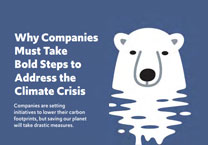Everything you need to know about corporate carbon pricing
by Tim Greiner
27 April 2016
 This interview with Tm Greiner originally appeared in Sustainable Brands.
This interview with Tm Greiner originally appeared in Sustainable Brands.
Advances in renewable energy, energy efficiency and energy storage are pushing us toward a more sustainable, low-carbon future, but an outright energy revolution is being held back by the fact that the market prices of coal, oil and gas include almost none of the costs of carbon pollution.
At the national level, putting a price on carbon will transform energy investment, re-shape consumption, and sharply reduce the carbon emissions that are driving global warming, according to the Carbon Tax Center. This “upstream” tax would target the carbon contents of fossil fuels, including coal, oil and natural gas, as well as biofuels.
While Congress has idled on putting a price on carbon, companies from Microsoft toUnilever already have implemented their own — which has in some cases provided a significant boost to the bottom line. Microsoft, for example, claims to be saving $10 million per year after its internal carbon fee helped it achieve carbon neutrality.
At the corporate level, pricing carbon allows companies to redirect funds toward sustainability investments, such as renewables, energy efficiency and energy storage, which can drive further cost savings in the long run.
To get a better understanding of pricing carbon in the corporate world, we spoke with Tim Greiner, co-founder and managing director at sustainability consulting firm Pure Strategies.
Why is a price on carbon needed?
Very aggressive reduction efforts will be required to achieve the 2°C target recommended by the IPCC to limit the effects of climate change. But at COP21 in Paris, we learned that even those efforts may be inadequate. Instead, we need to focus on the more ambitious target of 1.5°C.
Setting a price on carbon is the most effective tool we have to quickly institute a decisive approach to achieving these necessary carbon reductions. Money is the most powerful currency in business. In my view, a pricing mechanism is the most efficient and effective way to spur systemic change.
Many companies realize the power of carbon pricing. According to CDP, over a thousand companies are currently pricing their carbon emissions or have plans to by 2017. We are moving beyond the pioneers in this space such as Microsoft, Disney and Google.
How does risk reduction factor into pricing carbon?
Risk reduction is an important part of the carbon pricing equation. Companies have real exposure to carbon regulation and taxation. Just look at the European Union, South Korea and China as well as eight northeastern states, California, and several Canadian provinces - they all have some type of carbon pricing. In fact, current pricing schemes cover roughly 22 percent of global emissions and I expect many more jurisdictions will follow suit. You don’t need a crystal ball to see this coming. That's why many forward-thinking companies are evaluating their exposure to these fees and taxes and choosing to minimize their exposure to these regulatory requirements. Take a look at GM. A study by students at the University of Michigan estimated GM’s exposure from $88M to $405M.
Are companies structuring their carbon pricing programs similarly? What are the differences?
There is incredible diversity in the way firms are choosing to set up and implement their programs. There are really important differences in what part of the value chain they cover and how companies make investment decisions.
From, a value chain perspective, most businesses are focusing mainly on Scope 1 and 2 emissions. That's where they have the most control and influence. Disney and TD Bank are good examples of this. But for many firms, the most significant greenhouse gas emissions may occur on the farm or in raw material extraction or processing – parts of the value chain that fall outside a company’s direct control. Relatively few companies are setting up pricing schemes in hot spots that are further up or down stream.
Regarding investment approach, many companies use carbon pricing to encourage their business units to shift away from carbon-heavy approaches, using the tax money for offsets or renewable energy credits. Microsoft, which has written a helpful guide to benefit other companies considering a carbon price, funds both internal energy efficiency and external projects such as a wind installation in Texas and biodiversity initiatives in Indonesia.
While most firms spend the bulk of their carbon funds internally, Ben & Jerry’s is taking a unique approach. The company is using their fee to fund investments in their suppliers – where their largest impacts are. Andrea Asch, Manager of Natural Resources at Ben & Jerry’s, likes to say that they “are committed to investing in the parts of their business that represent the greatest climate impact.” That means focusing on their value chain, specifically their dairy farms, which represent the largest source of the company’s GHG emissions.
At what level are companies pricing carbon, and how does pricing filter down through the business?
We’re all still uncovering the most effective way to price carbon. CDP found companies setting prices that ranged from $3 to $357 per ton. The EPA has set the social cost of carbon at $36 per ton. EPA’s price reflects an estimate of the economic damage associated with a small increase in carbon dioxide (CO2) emissions – let’s say a metric ton of CO2 – in a given year. But others think the cost is much higher. As a practical matter, many firms determine their prices by dividing their emissions by the level of funding they can support.
Once the price is set, it is critical to determine how to bring the price into the corporate budgeting process. Disney is an interesting example of a large company with an effective approach. Disney applies their fee at the business unit level so an individual cruise ship or theme park pays in proportion to their emissions. This gives every business unit an incentive to reduce emissions. Furthermore, incorporating the carbon fee directly into budgets means that capital investments decisions that decrease emissions will have higher long-term returns.
Looking at all of this, what is the best approach for a company when it comes to implementing a price on carbon?
That's a hard question. There is no one-size-fits-all approach as businesses vary in so many ways. But putting business differences aside, best practice would include investing internally or in the supply chain rather than only purchasing offsets. Another critical element is establishing an internal market to create competition for the best-in-class reduction approaches. Additionally, I look for carbon pricing that addresses the material parts of the business beyond Scope 1 and 2 boundaries.
Finally, long-term thinking is critical. Businesses should avoid investments with short-term returns that don’t align with a future that is free of fossil fuels. If your goal is energy-positive manufacturing facilities by 2030, are the investments you are making in 2016 helping you get there? I’ve seen companies invest in short-term, more-efficient build-outs without considering their long-term needs for more comprehensive solutions such as renewable energy infrastructure and radical energy efficiency improvements.
Where do you think carbon pricing is headed?
Maybe I’m too bullish on carbon pricing, but I see it sweeping the globe by 2030. This is the first time that we’ve had businesses collectively internalizing damaging environmental externalities on a massive scale. It may pave the way for us to start paying the full social cost for the environmental degradation of our waters, soils and species diversity. The risks here are cataclysmic; we have to get it right.
Written by Tim Greiner
Tim Greiner, a Pure Strategies Co-founder and Managing Director, has pioneered approaches to building environmental and social integrity into products, brands, and businesses. He is also a co-founder of the Chemical Footprint Project and has guided sustainable chemicals management strategies for companies across diverse industries. His experience spans the spectrum from developing sustainability strategy, drafting sustainability goals, designing product sustainability programs, creating approaches to transform sustainable supply chains and facilitating a landscape level stakeholder process to improve climate and water quality outcomes.
Tim's recent projects include helping build a leading climate strategy for Ben & Jerry's, developing sustainability goals for King Arthur Baking, creating a corporate sustainability strategy for Lush, and developing a regenerative grazing standard for Timberland.












